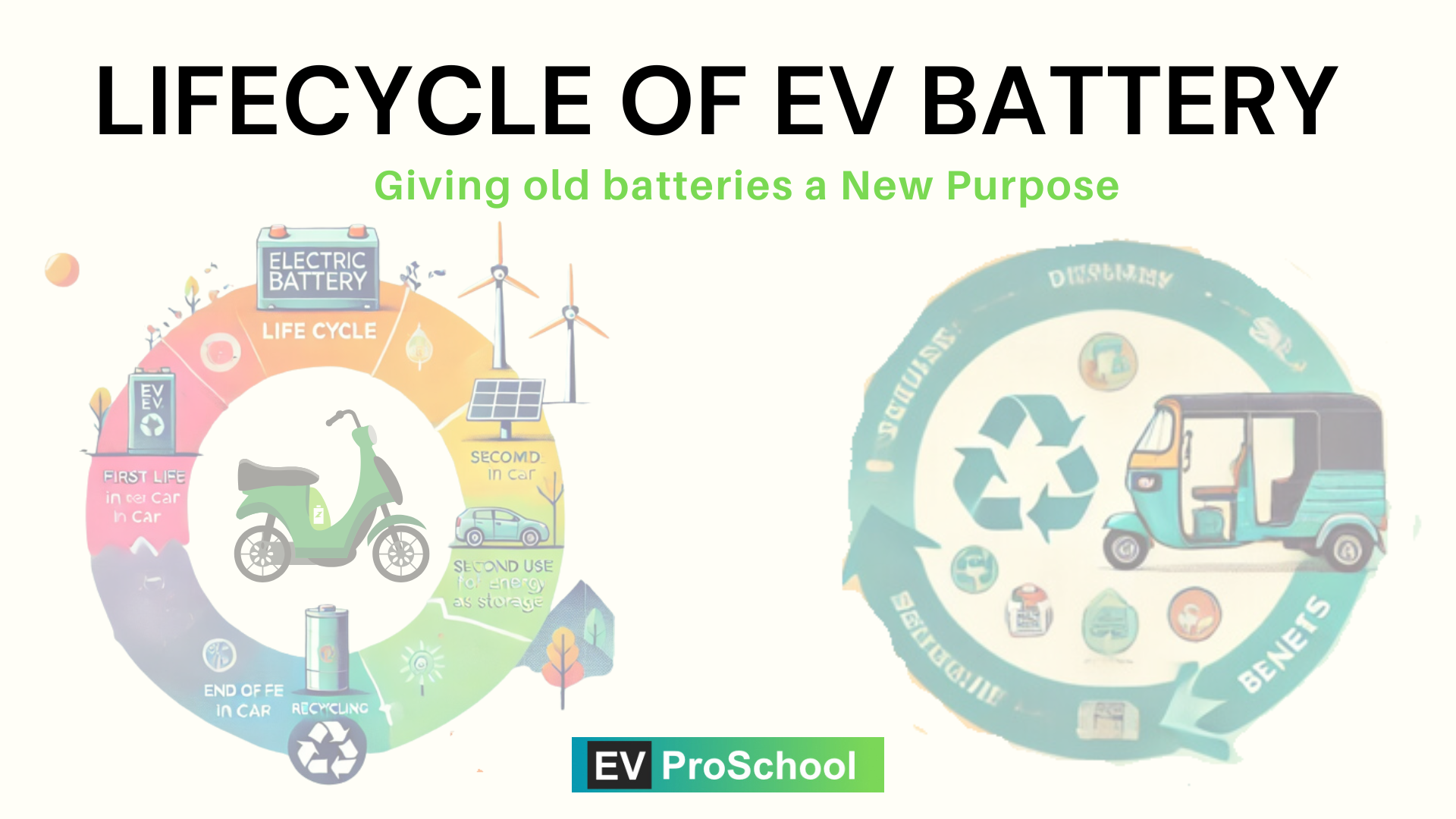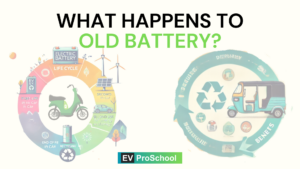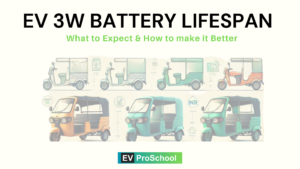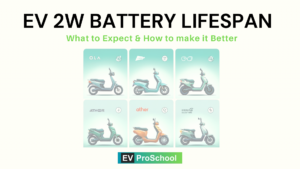Detailed Blog Post Strategy: “Life Cycle Assessment of Electric 2W & 3W Batteries”
This blog post will analyze the entire lifecycle of electric two-wheeler (2W) and three-wheeler (3W) batteries, covering production, usage, and recycling phases, with a focus on their environmental impact and carbon footprint. The post will incorporate India-specific insights, explore global trends, and offer actionable recommendations for reducing battery-related emissions.
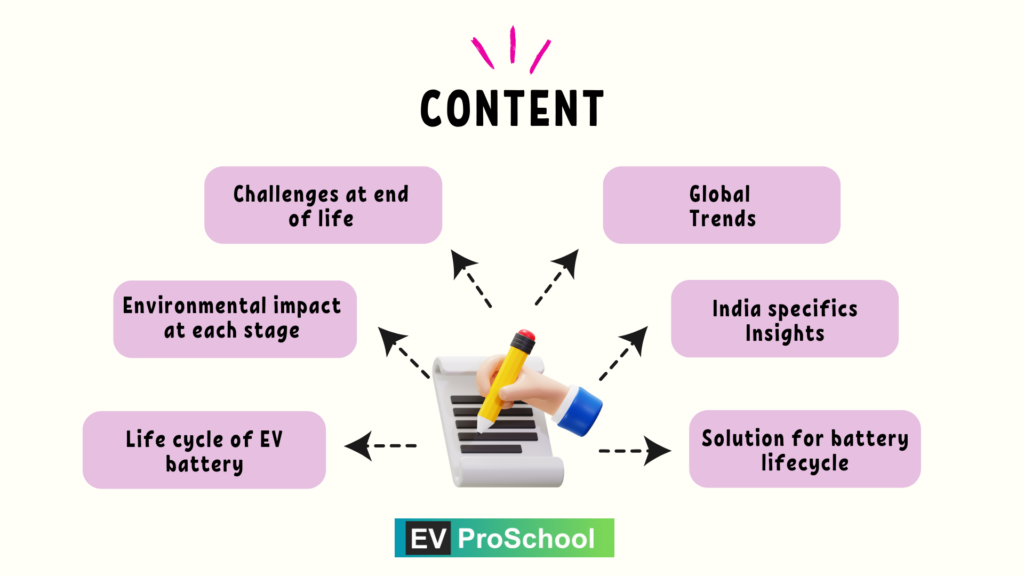
1. Objectives
Purpose:
• To educate readers about the environmental impact of EV batteries from produc tion to recycling.
• Highlight the carbon footprint at each stage and discuss strategies for minimizing emissions.
• Provide global trends and innovations for sustainable battery lifecycle management.
2. Target Audience
• EV owners and enthusiasts interested in the environmental aspects of battery production and disposal.
• Policymakers and sustainability advocates exploring ways to make EVs more eco-friendly.
• Industry professionals and startups seeking insights into sustainable battery practices.
3. Blog Outline
Title Options:
• Main Title: Life Cycle Assessment of Electric 2W & 3W Batteries
• SEO-Friendly Title: Environmental Impact of EV Batteries: From Production to Recycling
Introduction: Understanding the Journey of an EV Battery
• Hook:
“Did you know that the journey of an EV battery—from mining raw materials to recycling—determines its true environmental impact?”
• Introduce the concept of life cycle assessment (LCA):
• A comprehensive analysis of the environmental impact of a product at every stage.
• Preview the blog: “In this post, we’ll analyze the lifecycle of 2W and 3W EV batteries, from production to recycling, and explore their carbon footprint and sustainability solutions.”
Section 1: The Lifecycle of an EV Battery
1. Production Phase
• Raw Material Extraction:
• Mining of lithium, cobalt, nickel, and manganese.
• Environmental concerns: High water consumption, habitat destruction, and pollution.
• Manufacturing Process:
• High energy consumption during battery cell production.
• Example: Manufacturing a lithium-ion battery can emit ~70–110 kg CO2 per kWh of capacity.
2. Usage Phase
• Efficiency During Operation:
• EV batteries reduce tailpipe emissions to zero.
• For Indian 2Ws and 3Ws, EVs can offset their production emissions in 1–2 years of usage compared to ICE vehicles.
• Battery Degradation:
• Gradual capacity loss over time, affecting energy efficiency.
3. End-of-Life Phase
• Recycling:
• Recovery of valuable materials like lithium, cobalt, and nickel.
• Reduces the need for raw material extraction.
• Reuse:
• Batteries repurposed for second-life applications, such as energy storage systems.
Section 2: Environmental Impact at Each Stage
1. Carbon Footprint of Production
• Mining and processing raw materials account for ~40% of the battery’s total lifecycle emissions.
• Example: Mining 1 ton of lithium requires ~500,000 gallons of water, impacting local ecosystems.
2. Carbon Offset During Usage
• EVs powered by renewable energy have a significantly lower carbon footprint compared to those charged using coal-based electricity.
• Stat: Indian 2Ws and 3Ws using grid electricity still emit ~50% less CO2 than ICE vehicles.
3. Challenges at End-of-Life
• Improper Disposal: Leads to environmental contamination.
• Energy-Intensive Recycling: Recycling processes like pyrometallurgy and hydrometallurgy emit CO2.
Section 3: Global Trends in Sustainable Battery Lifecycles
1. Transition to Cobalt-Free Batteries
• Reduces reliance on environmentally damaging cobalt mining.
• Example: LFP (Lithium Iron Phosphate) batteries are gaining popularity for 2Ws and 3Ws.
2. Renewable Energy-Powered Manufacturing
• Companies like Tesla and CATL are building gigafactories powered by solar and wind energy.
3. AI in Battery Recycling
• AI-driven sorting technologies improve material recovery rates and reduce emissions during recycling.
4. Closed-Loop Systems
• Manufacturers like Umicore and Lohum Cleantech are creating closed-loop supply chains to reuse materials from old batteries.
Section 4: India-Specific Insights
1. Rising EV Adoption
• India’s two- and three-wheeler market is rapidly electrifying, with over 50% of new sales in 2W expected to be electric by 2030.
2. Challenges in Recycling Infrastructure
• Limited number of battery recycling plants in India.
• Informal recycling practices can lead to pollution and material wastage.
3. Government Policies
• FAME II subsidies incentivize sustainable EV adoption.
• India’s Battery Waste Management Rules 2022 mandate proper disposal and recycling.
4. Local Innovations
• Sun Mobility: Battery swapping stations that promote efficient reuse.
• Tata Chemicals: Building India’s battery recycling ecosystem.
Section 5: Solutions for a Greener Battery Lifecycle
1. Use of Renewable Energy in Charging and Manufacturing
• Powering 2Ws and 3Ws with solar energy can reduce lifecycle emissions by up to 40%.
2. Consumer Awareness
• Educating EV users about proper charging practices and recycling options.
3. Investment in Recycling Infrastructure
• Scaling up recycling facilities in India to handle the expected surge in battery waste.
4. Second-Life Applications
• Promoting the use of retired EV batteries for rural electrification and backup power.
Conclusion: Building a Sustainable Future for EVs
• Recap the importance of analyzing the lifecycle of EV batteries to understand their true environmental impact.
• Emphasize the role of innovations, government policies, and consumer awareness in minimizing the carbon footprint of 2W and 3W batteries.
• End with a call-to-action:
“Together, we can make EVs not just a solution for cleaner transport, but a cornerstone of a sustainable future.”
4. Writing Style and Tone
• Tone: Educational yet optimistic, emphasizing solutions and innovations.
• Use analogies to simplify technical concepts:
• “Think of an EV battery as a marathon runner—it needs the right training (production), performance (usage), and recovery (recycling) to excel.”
5. Suggested Visuals and Graphics
1. Lifecycle Diagram: From production to recycling, showing emissions at each stage.
2. Infographic: Carbon footprint comparison of EV batteries and ICE engines.
3. Global Trends Map: Highlighting countries and companies leading in sustainable battery practices.
4. Bar Chart: Environmental benefits of battery reuse vs recycling.
6. SEO Optimization Strategy
Focus Keyword:
“Lifecycle assessment of EV batteries”
Supporting Keywords:
• Environmental impact of EV batteries
• Carbon footprint of 2W and 3W batteries
• Sustainable EV battery recycling
• Life cycle analysis for electric vehicle batteries
Meta Description:
“Analyze the lifecycle of electric two-wheeler and three-wheeler batteries, from production to recycling. Discover their environmental impact, carbon footprint, and global trends in sustainability.”
Alt Text for Feature Image:
“Diagram showing the lifecycle of EV batteries, from production to recycling, and their environmental impact.”
7. Blog Length and Target Audience
• Word Count: 2,000–2,400 words to provide a detailed analysis.
• Target Audience: EV users, sustainability advocates, policymakers, and industry professionals.
This strategy provides a comprehensive and actionable perspective on the lifecycle of 2W and 3W EV batteries, tailored to India’s context and global trends in sustainability.
